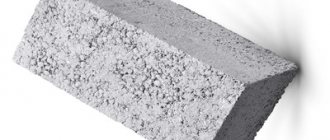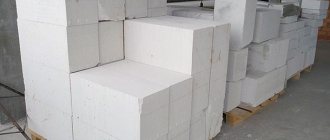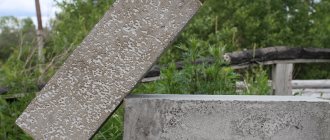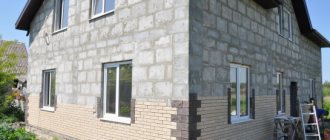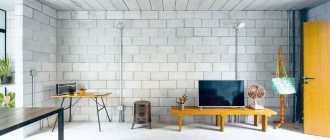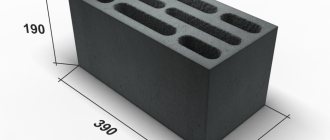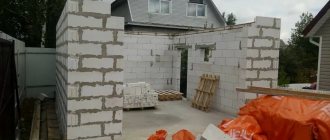Expanded clay concrete blocks belong to the class of lightweight concrete. They are in demand during the construction of various objects and structures. They are an excellent alternative to brick, as they allow you to lay out walls faster due to their size, create less load on the foundation, are fire resistant, have better thermal insulation properties, and do not contain toxic materials.
Main characteristics
Expanded clay concrete blocks have the shape of a rectangular parallelepiped. It can be manufactured with flat end walls, as well as with grooves or tongues with ridges. The corners of the ends can be regular straight or rounded. The supporting surfaces for laying rows have a flat shape or with longitudinal grooves located from the edges of the plane at a distance of more than 2 cm.
Sand, cement, water and expanded clay are used as raw materials for production. All ingredients are mixed to a homogeneous solution, distributed into molds, and left to dry naturally for 28 days under certain conditions. There are 2 ways to increase strength and increase the production speed of expanded clay blocks:
- Autoclave, steam treatment is carried out under a certain pressure.
- Vibrocompression, the forms are placed on a vibration installation, in which all internal defects of the solution are eliminated, and at the same time they are subjected to a press to increase density.
Due to the high hygroscopicity of expanded clay, it is quite difficult to provide optimal conditions for hardening. To do this, it is necessary to constantly maintain the calculated level of moisture in the blocks so that the concrete can gain strength. If the technical requirements for hardening are not met, then the expanded clay concrete will become brittle and will not withstand the design loads.
Types of blocks by design
Expanded clay concrete blocks according to the type of construction are divided into the following types:
- Full-bodied. They have great strength and are intended for laying load-bearing structures. Used in the construction of single- and multi-storey buildings.
- Hollow. They are produced with a certain number of evenly distributed voids inside the material. They are inferior in strength to solid ones, but superior in heat and sound insulation characteristics, and are intended for the construction of low-rise buildings. They have a peculiarity during installation: the voids must be laid on a cement-sand mortar.
Classification of blocks by purpose
According to their intended purpose, expanded clay concrete blocks are:
- Wall, used for the construction of load-bearing and enclosing structures of buildings and structures;
- Partition walls are used only when constructing partitions between rooms that do not perform load-bearing functions for the entire building, with the exception of low-rise buildings;
- Ventilation, used for laying ventilation ducts;
- Facing, used for exterior wall decoration, differs from other types in high insulating properties, precise adherence to geometry, absence of minor defects, and optimal decorative characteristics.
An example of how the characteristics of an expanded clay block measuring 39x19x18.8 cm are affected by the number of voids, table of parameters.
| Properties | Block with 2 voids | With 4 slits | With 8 slits | Full-bodied |
| Thermal conductivity coefficient, W/m•K | 0,35 | 0,35 | 0,35 | 0,3 |
| Strength grade | M50 | M50 | M75 | M100 |
| Density, kg/m3 | 1050 | 1050 | 1150 | 1150 |
| Frost resistance class | F50 | F50 | F50 | F50 |
Size of expanded clay concrete blocks (tables)
Depending on the manufacturer, expanded clay blocks may have different sizes. Here are 2 tables of the most popular ones.
Table of standard sizes of expanded clay blocks
Nominal size according to GOST 6133-99 “Concrete wall stones”.
| Purpose | Length, cm | Width, cm | Height, cm |
| Wall | 39 | 19 | 18,8 |
| 28,8 | 28,8 | 13,8 | |
| 28,8 | 13,8 | 13,8 | |
| 28,8 | 19 | 18,8 | |
| 19 | 19 | 18,8 | |
| 9 | 19 | 18,8 | |
| Septal | 59 | 9 | 18,8 |
| 39 | 9 | 18,8 | |
| 19 | 9 | 18,8 |
Table of sizes of expanded clay concrete blocks "ThermoComfort"
| Type of expanded clay block | Length, mm | Width, mm | Height, mm |
| Wall slot type | 340 | 400 | 240 |
| 490 | 300 | 240 | |
| 490 | 200 | 240 | |
| Solid wall type | 490 | 300 | 185 |
| 490 | 250 | 185 | |
| 490 | 200 | 185 | |
| Septal | 490 | 100 | 240 |
| For jumpers | 225 | 300 (200) | 240 (180) |
| 225 | 200 (100) | 240 (180) | |
| Ventilation single channel | 400 (320) | 400 (320) | 240 |
| Ventilation two-channel | 400 (140) | 300 (220) | 240 |
Properties of expanded clay concrete blocks
The main ones are the strength characteristics of the blocks, which make it possible to select them for a structure or object and ensure compliance with the parameters of the design documentation. Strength depends entirely on the density of the material, and also determines the heat and sound insulation properties.
The density is in the range of 500-1800 kg/m3, and the weight is 10-30 kg, respectively, depending on the type of blocks. The strength coefficient varies within 3.5-20 and, according to GOST 6133-99, is maintained during operation for at least 6 decades.
Based on frost resistance, blocks are divided into classes: F200, F150, F125, F100, F75, F50, F35, F25, F15. The numbers in the marking determine the minimum number of freezing/defrosting cycles during which all the properties of the expanded clay block are guaranteed to be preserved.
Fire resistance class of expanded clay concrete block A1 (non-flammable). This means that it can withstand contact with fire for a period of 7 to 10 hours without igniting or losing performance.
Standard sizes according to GOST
Expanded clay blocks are manufactured in accordance with GOST, however, this does not imply the use of identical standard sizes. Depending on the structure and purpose, the following material sizes are found on the market:
- Wall. Length – 190-390 mm, width – 138-288 mm, height – 138-188 mm.
- Septal. Length – 190-590 mm, width – 90-120 mm, height – 188 mm.
- Ventilation. The size used here is 390*190*188 mm.
Note that such standard sizes are regulated by GOST number 6133 as amended in 1999 . Some nuances and errors are acceptable here, so the product sizes given are recommended rather than reference.
| Block type | Length(Lmm) | Width (bmm) | Height (hmm) | Number of blocks in a pallet |
| Wall | 288 | 288 | 138 | 75, 90, 180 |
| 288 | 138 | 138 | 75, 90, 180 | |
| 390 | 190 | 138 | 75, 90, 180 | |
| 290 (288) | 190 | 138 | 75, 90, 180 | |
| 190 | 190 | 138 | 75, 90, 180 | |
| 90 | 190 | 138 | 75, 90, 180 | |
| Septal | 590 | 90 | 188 | 180 |
| 390 | 90 | 188 | 312 | |
| 190 | 90 | 188 | 500 |
With decorative coating
Advantages of expanded clay blocks
The following advantages of expanded clay concrete blocks are highlighted:
- light weight compared to sand-lime or red brick, allowing the construction of objects with a reduction in foundation costs by approximately 30%;
- high level of heat and sound insulation compared to other concrete-based materials, therefore, insulation costs will be significantly reduced;
- the absence of toxic components, due to which buildings for any purpose can be built, there is no danger to human health or harm to the environment;
- the minimum service life is 50 years, depending on climatic conditions and loads;
- provide natural air exchange due to the regulation of the amount of moisture by the expanded clay present in the material;
- fire resistance, ensuring a high level of fire resistance of constructed objects;
- high speed of masonry, compared to brick, due to its size, ease of processing with cutting tools and relatively low weight;
- resistance to chemically active substances, biological microorganisms, fungus, mold.
Benefits of constructing buildings from expanded clay concrete blocks
When constructing buildings, expanded clay concrete, compared to other materials, has a number of advantages:
- no lime is used in production, so the laid steel reinforced belt is not subject to corrosion processes;
- walls do not shrink;
- it is allowed to use ordinary cement-sand mortar to form joints;
- the sound insulation level is 49-54 dB for interior partitions, and for external walls 47-55 dB (depending on the density and size of the block);
- finishing with any building materials, including natural ones, is allowed;
- low consumption of mortar for masonry compared to bricks.
Comparison with other types of materials
Table comparing the characteristics of expanded clay concrete blocks with other building materials for the construction of walls.
| Material | Density, kg/m3 | Thermal conductivity, W/m•K | Frost resistance, number of cycles |
| Expanded clay concrete | 700-1500 | 0,15-0,45 | 15-200 |
| Foam concrete | 450-900 | 0,10-0,40 | 25-50 |
| Brick | 1000-2000 | 0,30-0,80 | 50-200 |
| Gas silicate | 200-600 | 0,10-0,30 | 10-30 |
| Sawdust concrete | 500-900 | 0,20-0,30 | 25-100 |
| Ceramic blocks | 600-800 | 0,20-0,50 | 20-50 |
| Tree | 400-700 | 0,09-0,18 | 35-100 |
| SIP panels | 30-50 | 0,03-0,09 | 20-50 |
Production technology and composition
The following raw materials are used for manufacturing: cement, expanded clay, water; the presence of fillers and plasticizing additives is allowed. For preparation, the following proportion of components is usually used - 8/3/1 for expanded clay, sand and cement.
It’s worth clarifying right away that the recipe is not a reference. By changing the ratio of components, the manufacturer can improve the characteristics of the finished product. For example, adding cement will increase strength, but will negatively affect thermal insulation. Adding expanded clay will increase the insulating properties, but will affect the strength of the block.
Water is added “to taste”, depending on the moisture content of the raw materials. Ideally, the finished solution should resemble thick sour cream in consistency. To do this, 2-3 minutes of mixing the components in a concrete mixer is enough.
Then the blocks are formed and the mixture is vibrated. At the final stage, the products are dried in molds for at least 2 days. After this, the blocks are removed from the molding containers and dried in the open air for about 8-10 days.
Main disadvantages
The disadvantages of expanded clay concrete blocks include the following characteristics:
- the need to use facing materials;
- fragility, requiring care during transportation, installation and handling;
- the impossibility of constructing facilities in regions with high levels of humidity, since due to porosity and temperature fluctuations, the expanded clay block will collapse before its expected service life, or it will be necessary to provide a high level of waterproofing;
- It is prohibited to use blocks to lay a monolithic foundation;
- the appearance of cold bridges in joints requires the use of blocks with precise geometry and high-quality cement-sand mortars;
- buildings must be heated during the cold season to prevent freezing.
How to reduce the influence of negative factors?
If negative factors are critical, then you should not refuse to choose expanded clay concrete for the construction of facilities. There are several methods to reduce their influence:
- if it is necessary to install hydro- and heat-insulating materials, ventilated facades should be formed, which will ensure sufficient air exchange and prevent the accumulation of moisture inside the expanded clay block, accordingly, the likelihood of freezing will be minimized;
- when constructing buildings from 2 floors and above, it is necessary to frame the walls, as well as laying reinforcing metal mesh every 3-4 rows;
- a one-story building can be built half the width, but with insulation, thus reducing construction costs by 30-40%.
Marking
When purchasing, you can see letters on the label that contain encrypted parameters of the material. The first letter “K” means that it is an artificial stone, 2 and 3 letters indicate the scope and purpose:
- P – septal;
- C – wall;
- R – ordinary (with external finishing);
- L – facial.
The next 2 letters specify the location of the block in the masonry:
- PS – hollow;
- PR – serial;
- UG – angular;
- PZ – ligation of sutures.
Then there is the number “39” - length in cm. After that the grades of strength, frost resistance, and density are indicated.
Typical solutions for the construction of objects from expanded clay concrete blocks for the middle zone
When constructing various buildings, it is important to follow construction technologies that ensure not only the preservation of the properties of materials, but also ensure a long service life of the objects. Typical solutions for the middle band:
- The walls are 30 cm thick, lined with insulation. For these purposes, you will need a block measuring 49x30x24 cm. Finish the interior with plasterboard or plaster, and insulate the exterior with mineral wool or polystyrene foam 10 cm thick.
- The walls are 40 cm thick, with the laying of thermal insulation materials 5 cm thick. You will need to use expanded clay blocks measuring 39x19x20 cm or 34x40x24 cm, insulation - mineral wool or expanded polystyrene.
- Multi-slot wall blocks 50 cm thick without sheathing with insulation. The dimensions will have to be selected with a length of 50 cm for laying in a row or 25 cm and laying in 2 rows. You will have to select the laying scheme yourself; laying expanded clay blocks with bandaging is considered convenient.
The construction of buildings from expanded clay concrete blocks is beneficial due to the high speed of construction, insulating properties, low weight and strength characteristics. Expanded clay blocks are practically not susceptible to negative environmental influences; the minimum service life is 50 years.
List of reliable manufacturers
When choosing a building material, the main attention is paid to its quality, on which the service life of the building will directly depend. Therefore, when purchasing expanded clay concrete, you can pay attention to the products of the following manufacturers:
- LLC "Yakovlevostroydetal " This is one of the largest domestic manufacturers, known as the Belgorod ZhBK-3 plant. The company has been operating for more than 50 years and was renamed in 2005 . The company strictly follows GOST standards, producing over 600 types of products.
- JSC "BCSM " This abbreviation hides the Beskudnikovsky Construction Materials Plant. The company was founded in 1926 , however, it began to specialize in the production of expanded clay concrete blocks in the 80s of the last century, after reconstruction. All manufactured products are subject to mandatory certification; there are conclusions from the SES on environmental safety.
- "Klinstroydetal" . This is the most famous manufacturer of bricks and tiles in Russia. It is worth noting that the company was one of the first in the central region of the country to launch a line for the production of expanded clay concrete blocks. High demands are placed on finished products; the technological process is controlled at all stages.
In addition, the products of JSC Keramzit, Serpukhov, and LLC Podmoskovye, located in Kolomna, deserve high marks from specialists.
